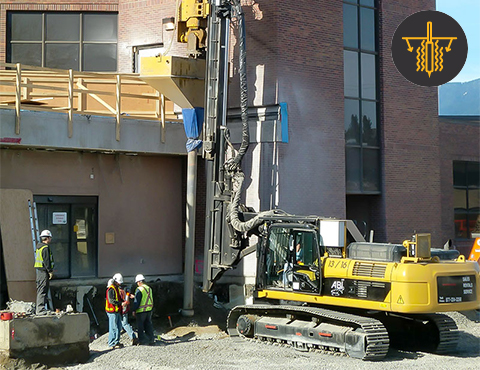
Vibro compaction is a system that comprises a series of piers constructed of uniformly graded aggregate (or stone) installed using specialized equipment.
Stone Columns are a series of crushed stone pillars placed with a vibrating tool into the soil below a proposed structure. This method of ground improvement is also called vibro replacement. Such techniques increase the load bearing capacity and drainage of the soil while reducing settlement and liquefaction potential. Stone columns are made across the area to be improved in a triangular or rectangular grid pattern. A layer of compacted gravel is then put over the top of the piers, ready for the construction of a structure. They have been used in Europe since the 1950s, and in the United States since the 1970s. Column depth depends on local soil strata, and usually penetrates weak soil.
Stone Columns – Ground Densification Solutions
Stone column densification is a ground improvement technique that involves installing stone columns (also known as granular piles) into loose or soft soils to increase their density and improve their load-bearing capacity. This process enhances soil strength and stiffness, making it suitable for supporting various structures and mitigating potential challenges such as settlement and liquefaction.
How it works:
Here at Rush we utilize the Dry method where as probe creates a borehole, and then granular material is dropped in and compacted by the probe, creating the stone column.
Compaction:
The vibrations from the probe compact the surrounding soil, increasing its density and shear strength.
Reinforcement:
The stone columns themselves act as reinforcing elements, providing additional support to the ground.
Drainage:
The stone columns can also improve drainage in the soil, helping to dissipate excess pore water pressure, which is crucial for preventing liquefaction during earthquakes.
Applications:
Liquefaction mitigation:
Stone columns are highly effective in mitigating the risk of soil liquefaction during earthquakes, where loose, saturated soils can lose strength and behave like a liquid.
- Increased load-bearing capacity: They increase the load-bearing capacity of the soil, allowing for the construction of heavier structures or foundations on otherwise unsuitable ground.
- Reduced settlement: Stone columns help reduce both total settlement and differential settlement, ensuring the stability of structures.
- Slope stability: They can be used to improve slope stability and prevent lateral spreading.
- Applications: Stone columns are used in a wide range of projects, including building foundations, embankments, retaining walls, and industrial facilities.
Benefits:
- Versatile: Stone columns can be adapted to various soil types and site conditions.
- Cost-effective: They can be a cost-effective solution compared to other ground improvement techniques, especially in granular soils.
- Proven technology: Stone columns have been used successfully for many years in numerous projects worldwide.
Interested in Stone Columns?
Do you have inquiries about our fully integrated solutions for your ground improvement needs? Contact one of our experts today.